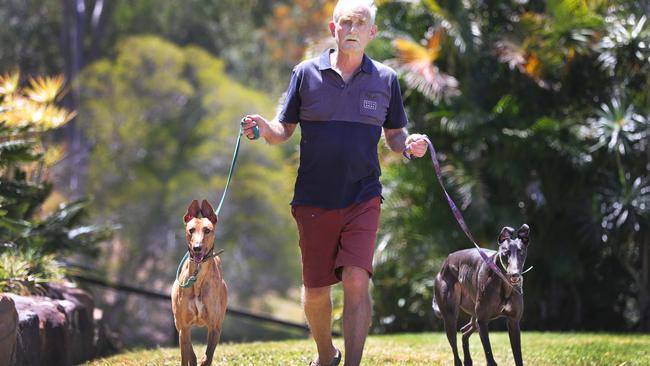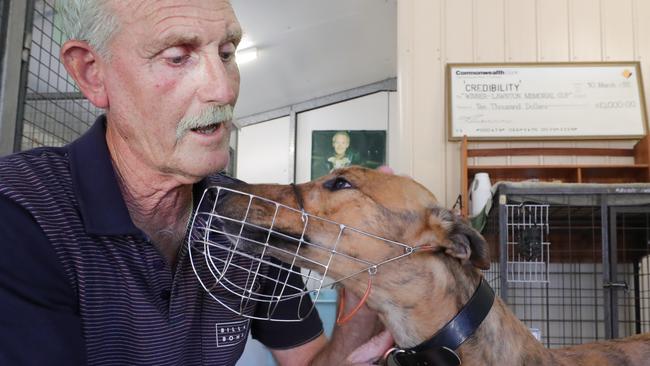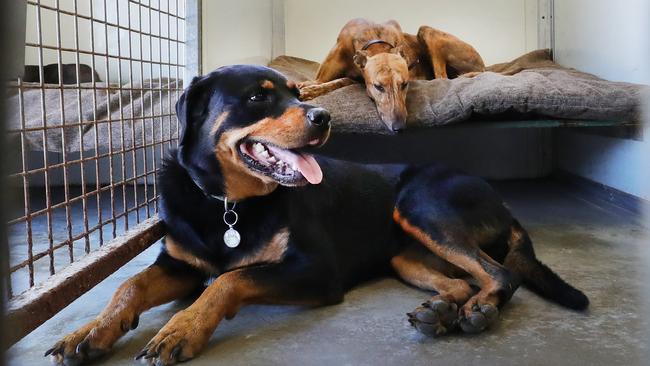New greyhound racing precinct proposed for Tweed Coast reignites fierce debate about integrity of racing industry
Greyhound bosses say the game has weeded out the bad eggs since the live baiting scandal, but not everyone agrees. WHAT DO YOU THINK?
Gold Coast
Don't miss out on the headlines from Gold Coast. Followed categories will be added to My News.
- Greyhounds battling own coronavirus strain in Queensland
- Why bashed greyhound has a long road to recovery
GREYHOUND racing was on the scrap heap five years ago. The NSW government wanted to ban the sport on the back of the live-baiting scandal, dog graveyards were discovered and some trainers exiled.
Then-NSW premier Mike Baird later overturned his decision to blacklist the code in his state, saying he “got it wrong” and that the majority of the community wanted the industry to have a second chance.
Greyhound bosses say the game has weeded out the bad eggs, it now holds the richest dog race in the world – the $1m TAB Million Dollar Chase – tougher animal welfare measures have been adopted, and Tweed is about to become home to a new state-of-the-art racing precinct.
MORE NEWS
Dog doping charge raises questions about meat supplies for Tasmanian greyhounds
The Tweed Heads Coursing Club bought a 32ha parcel of land at Chinderah for $2 million in August that will be transformed into the biggest and safest track in the country.
A Greyhound Racing NSW spokesman said the latest technology and design would go into the estimated $15 million “state of the art” facility.
“When up and running, the facility will generate $1.5 million annually to local participants through prizemoney, offer substantial employment opportunities for the local region, and engage with the local community particularly during the running of feature events,” he said.
“GRNSW has taken on board the University of Technology Sydney study and continues to work on putting in place a number of recommendations to benefit the industry and welfare of our animals.
“It should also be noted that GRNSW has worked incredibly hard and invested substantially on welfare in recent times, and in the past year, injuries at racetracks were down 45 per cent, while catastrophic injuries have decreased to their lowest rate in NSW since reporting began in 2016.”
But not everyone agrees.

Coalition for the Protection of Greyhounds president Dennis Anderson said Greyhound Racing NSW commissioned a report by the University of Technology Sydney that explained how dogs were injured on tracks.
He said the “comprehensive report” released in 2017 had three main recommendations for the industry – dogs to race on a straight track only, reduce the race field to six dogs and move the location of the lure.
“The media release on the proposed new track at Tweed Heads said there will be a straight track and a circle track,” Mr Anderson said.
“Why are they ignoring their own industry’s advice?”
Tweed Heads Coursing Club secretary Stephen McGrath declined to comment.

THE SCANDAL
Australia’s greyhound racing industry was in turmoil after ABC’s Four Corners exposed live baiting during training sessions.
The footage included live piglets, possums and rabbits being fixed to mechanical lures and catapulted around tracks while being chased – and killed – by dogs.
One clip, secretly filmed at training tracks in Queensland and Victoria, showed dogs being allowed to attack a writhing possum suspended from a lure.
Greyhound racing leaders say the trainers involved in the scandal were a “small minority of people”.
Gold Coast’s Tony Zammit has spent his entire career preparing greyhounds and said the scandal created a misconception that every trainer was involved in live baiting.
“It’s the stigma these PETA mob put out there that greyhound trainers are cruel and they kill their dogs when they’ve finished racing and they only care about them for the money,” Mr Zammit said.

BREAKING THE STIGMA
Mr Zammit sits on various committees dedicated to improving the industry.
The latest is a program run by the Queensland Racing Integrity Commission (QRIC), formed in response to the live baiting scandal.
QRIC claims to uphold the integrity of the Queensland racing industry through transparency, as well as founding the Greyhound Adoption Program, a scheme “dedicated to finding homes for retired racing greyhounds”.
Mr Zammit said QRIC also funded a program that paid for veterinarian costs for dogs injured during a race to help prevent the number destroyed.
“That way on the day if something happens (trainers and owners) are not stuck in a quandary and say, ‘Can I afford to pay for a dog to get fixed up?’
“The owner takes it home and looks after it and then if they want to keep it as a pet, they can, or if they want to give it up for adoption, they can.

“If the dog comes back to racing they have to pay the money back for the veterinary expense.”
Mr Zammit said there was a veterinarian and stewards at all race meetings to ensure the welfare of the dogs.
“If a dog gets knocked or bumped in a race, then the stewards might say to take the dog to the vet.
“The vet checks it over and if the dog has got a little injury, the vet might give it 14 days off.
“That’s where these animal welfare groups have got to realise people aren’t in it just for the money.
“In all the years I’ve been involved, most of the dogs I train, I train for other people, but it’s amazing how many have taken them home as pets when (the dogs) retire.”
Mr Anderson said he rejected the claim the industry cared about the welfare of the dogs citing the number that had died on Queensland race tracks this financial year.
“They’re trying to say they’re looking after the dogs, but if you’re looking after them, how come 63 were killed on the track in the financial year 2019-20 – and they are the QIRC figures.”

GREYHOUND ADOPTION PROGRAM
The Greyhound Adoption Program is an initiative that helps to find homes for retired greyhounds.
It was created as a welfare initiative of Racing Queensland in 2004 and moved under the QRIC banner following the passing of the Racing Integrity Act.
Acting Racing Integrity Commissioner Mark Ainsworth said 1055 greyhounds had been adopted by Queensland families at the end of the last financial year and demand was not slowing.
“Greyhounds as pets have grown in popularity … the industry plays a large part in ensuring there is life after racing for their canine athletes.”
However, Mr Anderson said it was hard to prove if greyhound adoption rates in Queensland had increased because the figures weren’t available previously.

He said the organisation had compiled figures on the number of greyhounds born and adopted in the past four years in NSW and Victoria, but those figures weren’t available in Queensland.
“So our question to the QRIC is, if you maintain every greyhound is going to find a loving home, give us the figures.
“If you’re prepared to make a statement like that, then you should be prepared to back it up.”

TRAINING A GREYHOUND
Tony Zammit is one of the most decorated trainers in Queensland greyhound racing: Multiple champions and premiership titles in 40 years in the sport.
Think champion chasers such as Pewterfrost, Trojan Tears, Credibility and Surf Lorian.
Today, he trains six greyhounds at his rural Willow Vale property. They are joined by retired racer Harley and a rottweiler Zeta.
The dogs are kept in kennels inside a cool Colorbond shed with the radio on “because it keeps them relaxed”.

They are trained most days from 5am on a straight track owned by a friend of Mr Zammit.
After training they are hosed down and brought home for a breakfast of Weet-Bix, powdered milk, chicken neck and various vitamins and minerals, including chia seeds, electrolytes and apple cider vinegar.
Several times throughout the day the dogs are let outside to toilet and sunbake.
Mr Zammit said the dogs rested a day either side of racing. Some days he took them for a walk in the evening with his granddaughter.
“It’s no different to a professional footballer,” he said. “You’re doing something with them every day. The day I run them up the straight, I don’t worry about walking them … but if there’s days I don’t run them, I’ll take them for a walk in the late afternoon.
“You have to treat them like an athlete. You want them to be fit. And when I say fit, you want their muscles to be strengthened, their joints strengthened.
“If they’re really fit they can cop a bump in a race.”
Mr Zammit said preparing a dog to race professionally was a long process.
Greyhound pups are reared and taught to walk on a lead by his brother George Zammit before they’re “broken in”.
“Then when they’re about 13 months you get them interested in chasing the squeaker.
“Breaking in means educating the dogs on how to chase a lure and then once they chase the lure properly, they teach them how to stand in a box.
“I now have them broken in somewhere else, then I get them.
“When they come back from being broken in, while it’s fresh in their mind, I might take them to the race tracks. Some days they race and then other days they’ll do trials only.”


